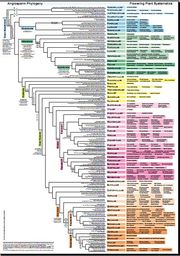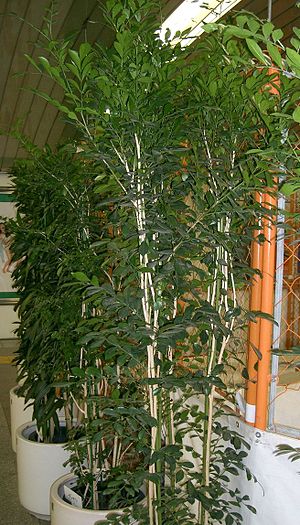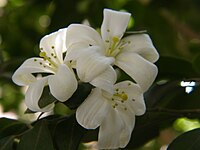Murraya exotica
Read community contributed articles on biodiversity & environment || Cultural practices & mythological stories related to Indian biodiversity || Official documents related to environment || NGOs, Blogs and Websites || Environment-related video collection || Plants of India || Mammals of India || Facebook || Twitter
Share this page: Murraya exotica
This species is used sometimes as an ornamental plant in India and has a medicinal use. Murraya exotica is related to Murraya koenigii or Curry plant, which is used as a spice in Indian foods. M. exotica leaves, on the other hand, have a citrus flavor.
Click here to see all Semantic Properties associated with this page
Please note that the above slideshow is automatically created by searching Flickr and does not contain manually curated images. Hence, it is likely that some images may not be exactly of Murraya exotica.
Click on the tabs below to know more...
- Species identity and nomenclature
- Current Wikipedia entry
- Binomial Classification
- Morphological features
- Habitat and Geographical Spread
- Maps
- Medicinal Importance
- Cultural significance
- Commercial importance and cultivation
- Summary of PubMed articles
- Summary of NCBI molecular data
- External Links
- Images and Videos
| Parameter | Value(s) | References See complete references in the References section at the end |
|---|---|---|
| Names of users who have contributed to this species page | Gauravm | |
| Date on which this page was first created | 2010/08/31 | |
| This page was last modified on: | 6 September 2010 15:02:57 | |
| Name of the species | Murraya exotica | |
| ID on Encyclopedia of Life | ||
| Synonyms | Please check Binomial Classification section for synonyms. | |
| Common English Names | Chinese box, Orange Jasmine | |
| Common Hindi Names | Kamini कामिनी | |
| Common Indian names | Kamini कामिनी (Hindi);কামিনী কুসুম Kamini kusum (Manipuri); வெங்காரை Vengarai (Tamil);Nagagolungu (Telugu);कुन्ती Kunti (Marathi);Kadu karibevu (Kannada);lMaramulla (Malayalam) | |
| Origins/Meanings of the common names |
Taxonomy from Encyclopedia of Life
If nothing is displayed in this section, it means the EoL ID has not been defined. Please click on Edit with form button on top and follow the instructions for filling in the EoL ID
{{#EoLOnlyHierarchy:}}
Taxonomy filled in form

Click here for the PDF of the phylogeny
| Taxon | Value |
|---|---|
| Regnum (Kingdom) | Plantae |
| Division | Magnoliophyta |
| Class | Magnoliopsida |
| Order | Sapindales |
| Family | Rutaceae |
| Genus | Murraya |
| Source of data | Encyclopedia of Life |
| ||||||||||||||||||||
| Division | Taxon details | Taxon morphology details |
|---|---|---|
| Magnoliophyta | Also called Angiospermae. The ancestors of flowering plants diverged from gymnosperms around 245–202 million years ago, and the first flowering plants known to exist are from 140 million years ago. They diversified enormously during the Lower Cretaceous and became widespread around 100 million years ago, but replaced conifers as the dominant trees only around 60-100 million years ago. | These are seed plants like Gymnosperms, but can be differentiated by the presence of flowers, seeds containing endosperm and seeds that produce a fruit. Angiosperms are the most diverse and highly evolutionarily successful group of land plants. |
| ||||||||||||||||||||
| Class | Taxon details | Taxon morphology details |
|---|---|---|
| Magnoliopsida | Magnoliopsida is the scientific name for dicots. This class contains about ~1,99,350 species of Angiosperms. Eudicots are a subset of Dicots. Based on chloroplast DNA sequences, the divergence date between monocots and dicots is estimated to be ~200 million years, with a 40 million years uncertainty. | Dicots are diverse in habit, with half of all the species being more or less woody-stemmed - a reflection of the usual presence of a vascular cambium in the class. Annuals, biennials, vines, epiphytes, aquatics, parasites, and saprotrophs are also well represented in dicots. Vascular bundles of the stem are usually borne in a ring that encloses the pith. Vessel elements present except in some putatively primitive woody or aquatic families. Most dicots have a primary root system derived from the radicle, although some have an adventitious root system commonly seen in the class of monocots. Cotyledons are usually 2, seldom 1, 3, or 4. Leaves are mostly net-veined. |
| ||||||||||||||||||||
|
|
Based on classification
More details can be found in the Binomial Classification section.
Morphology from Encyclopedia of Life
If nothing is displayed in this section, it means the EoL ID has not been defined. Please click on Edit with form button on top and follow the instructions for filling in the EoL ID
{{#EoLOnlyDescription:}}
General morphology
| Parameter | Value(s) | References See complete references in the References section at the end |
|---|---|---|
| General morphological features of the plant | Trees to 8 m tall. Older branchlets grayish white to pale yellowish gray. Leaves 3-7-foliolate; petiolules rather short; leaflet blades elliptic-obovate or obovate, 1-6 × 0.5-3 cm, margin entire, apex rounded or obtuse. Inflorescences terminal or terminal and axillary. Flowers 5-merous, fragrant. Sepals ovate, ca. 1.5 mm. Petals white, oblong, 1-1.5 cm. Stamens 10. Fruit orange to vermilion, broadly ovoid, 8-12 × 6-10 mm. Seeds villous. Fl. Apr-Aug, fr. Sep-Dec. 2n = 18*."Trees to 8 m tall. Older branchlets grayish white to pale yellowish gray. Leaves 3-7-foliolate; petiolules rather short; leaflet blades elliptic-obovate or obovate, 1-6 × 0.5-3 cm, margin entire, apex rounded or obtuse. Inflorescences terminal or terminal and axillary. Flowers 5-merous, fragrant. Sepals ovate, ca. 1.5 mm. Petals white, oblong, 1-1.5 cm. Stamens 10. Fruit orange to vermilion, broadly ovoid, 8-12 × 6-10 mm. Seeds villous. Fl. Apr-Aug, fr. Sep-Dec. 2n = 18*." cannot be used as a page name in this wiki. | Encyclopedia of Life through eFloras |
| Seed dispersal mechanism | ||
|---|---|---|
| Bloom type | Perennial | |
| Life cycle of the plant | The plant flowers irregularly throughout the year. Peak blooming time is mostly summer, when it has lots of sunlight. Fruits average ~0.3g/fruit. Plants can live atleast 15 years. | Francis USDA |
How to identify this species
For a detailed description, refer to the General Morphology details above
| Parameter | Value(s) | References See complete references in the References section at the end |
|---|---|---|
| Type of plant | Woody (Tree/Shrub) | |
| Plant height | More than 10 feet | |
| Flower color | White | |
| Flower shape | ||
| Floral symmetry | ||
| Phyllotaxy of leaves | ||
| Leaf shape | Obovate | |
| Is the leaf petiolated or sessile? | Petiolated | |
| Is the leaf simple or compound? | Compound |
| Parameter | Value(s) | References See complete references in the References section at the end |
|---|---|---|
| IUCN Conservation Status | Not Evaluated | EoL |
| Indian States in which the species has been documented | Assam,Andhra Pradesh,Andaman and Nicobar Islands,Arunachal Pradesh,Bihar,Delhi,Goa,Himachal Pradesh,Jammu and Kashmir,Karnataka,Kerala,Madhya Pradesh,Maharashtra,Manipur,Meghalaya,Mizoram,Rajasthan,Sikkim,Tamil Nadu,Tripura,Uttarakhand,Uttar Pradesh,West Bengal | Plants Database of India |
| Locations at which the species has been documented | Andaman;Changlang;Dibang;Kameng;Siang;Subansiri;Bhagalpur;Champaran;Giridih;Hazaribagh;Singhbhum;West champaran;Kangra;Shimla;Bangalore;Chikmaglore;Dharwad;Hassan;Kodagu;Kolar;Mysore;Shimla;Shimoga;Palaghat;Bastar;Bhopal;Damoh;Hoshangabad;Raigarh;Ahmednagar;Ahmednagar;Amaravati;Bombay;Kolhapur;Pune;Raigad;Satara;Sindhudurg;Imphal;Jowai;Lunglei;Banswara;Palani;Tirunelveli;Agra;Gorakhpur;Dehradun;Calcutta | Plants Database of India |
| Biotic zones inhabited | Northeastern Himalayas, Northwestern Himalayas, Eastern Ghats, Western Ghats, Central Deccan Plateau, East Coast, West Coast, Indo-Gangetic Plain, Outlying Islands | Based on Plants Database of India |
| Details about the habitat | The native range is China, India, Sri Lanka and other regions in South East Asia. It is a tropical species and has also been naturalized in many locations such as Puerto Rico. Some authors consider M. paniculata and M. exotica as separate species, but they have been identified in the Species 2000 list as synonyms.
The plant is highly adapted to many environments and can grow from sea level to 1300m. Grows on soils derived from both sedimentary and igneous rocks, although it may prefer limestone areas. Plants are hardy and survive at temperatures upto -4C. |
Francis USDA |
| Is this species native to India? | ||
| Is the species indigenous/endemic to Sub-Himalayan regions? | ||
| Is the species indigenous/endemic to Western Ghats? | ||
| Is the species indigenous/endemic to Eastern Ghats? |
|
Plant is not native or native status not filled in |
If no maps are displayed below, it means the required data is absent. Click on "Edit with form" button on top of the page to add this information.
{{#generateMap:Assam,Andhra Pradesh,Andaman and Nicobar Islands,Arunachal Pradesh,Bihar,Delhi,Goa,Himachal Pradesh,Jammu and Kashmir,Karnataka,Kerala,Madhya Pradesh,Maharashtra,Manipur,Meghalaya,Mizoram,Rajasthan,Sikkim,Tamil Nadu,Tripura,Uttarakhand,Uttar Pradesh,West Bengal|Murrayaexotica_brahma.svg|align=center}}
| Parameter | Value(s) | References See complete references in the References section at the end |
|---|---|---|
| Does this species have any medicinal use? | Yes |
|
Other plants of the same family having medicinal use:
|
| Parameter | Value(s) | References See complete references in the References section at the end |
|---|---|---|
| General types of ailments this species is used for treating | Infectious diseases, Accidents, Pains and Inflammation, Common ailments | |
| Specific ailments for which the species is used | Joint pain, Body aches, Venereal disease, Diarrhea, Dysentery, Wound, Abortion | Francis USDA |
| Medicinal systems which use this plant | Folk Medicine | Francis USDA |
| Details of Medicinal use | ||
| Parts of the plant used for treatment | Stem, Leaves | Francis USDA |
| Names of some medicinal active compounds in this plant, if known. | Yuehchukene, Oils, Flavonoids, Coumarins | Francis USDA |
| Details of the active chemical compounds found in this plant | ||
| Is the molecular basis of the medicinal action known? | ||
| Details of molecular basis of action | ||
| Are the toxic effects of consumption of this plant known? | Yes | |
| Details of the toxic effects of the plant species | In high doses, can be abortive. Pregnant females should avoid ingestion. | Francis USDA |
| Have there been validation/clinical studies related to this plant? | ||
| Details of the clinical studies related to the plant species |
| Parameter | Value(s) | References See complete references in the References section at the end |
|---|---|---|
| Is this plant/plant-derived product used in food preparations? | No | User-reported |
| Part(s) of the plant used in the food preparations | ||
| Details of use in food preparations | ||
| Does this species have any religious significance? | No | User-reported |
| Religions which mention/give significance to this species | ||
| Religious occasions | ||
| Details of religious use |
| Parameter | Value(s) | References See complete references in the References section at the end |
|---|---|---|
| Is this plant cultivated commercially in India? | Yes | |
| Uses for which the plant is commercially cultivated | Medicinal use, Ornamental use, Wood, Other use | Francis USDA |
| Plant parts of commercial value | Entire plant, Stem, Leaves | Francis USDA |
| Products where this plant is used | User-reported | |
| Description of use | It is a popular hedge plant in tropics. It can be pruned into various shapes of animals and can be used as a garden ornamental plant. It can also be cultivated as a bonsai. Can also be grown indoors.
The wood of the plant is soft and can be used for making small, fine-tuned items. Orange Jasmine contributes to biodiversity, protects the soil, furnishes food and cover for wildlife. It also has medicinal use as previously described. |
Francis USDA |
| States where this plant is cultivated commercially | ||
| Best period for planting this plant | ||
| Best period for harvesting this plant | Summer, All year round | |
| Method of propagation | Seeds, Vegetative propagation | |
| Water requirement of this plant | Average | |
| Pests and Diseases affecting this plant during cultivation | Whiteflies, Scale insects, Nematodes, Powdery mildew, Sooty mold, Citrus Psyllid | Francis USDA |
| Other considerations while cultivating this plant | The plant can be sown on commercial potting mix. 65% of seeds germinate in 25-60 days of sowing. Germination is hypogenous. Seedlings develop quickly, develop deep roots and grow at a moderate rate. Plants coppice very quickly if disturbed. Once they are established as ornamentals, very little care is needed. It can be killed easily by herbicides or by uprooting.
The plant is a preferred host of the Citrus Psyllid, Diaphorina citrii, which causes "citrus greening" disease and is also the host of Mediterranean fruit flies. |
Francis USDA |
Pubmed Word cloud
This word cloud is obtained using the tool LigerCat by searching the Pubmed database. LigerCat builds the cloud from the most relevant Medical Subject Headings (MeSH) terms. Each term's relative size indicates how many times it appears in the PubMed search results. Click on a term to access the full LigerCat cloud, with live PubMed search capabilities. LigerCat has been developed for the Biology of Aging Project.
The page may take some time to load since LigerCat is searching the entire PubMed database and sending us the results in real time.
- If there is an error message below, it means that there is no retrievable information available on NCBI
- If the number of nucleotide sequences is less than 100, very little genomic work has been done on this species. A respectable number of nucleotide sequences is above 10000.
- Most of the nucleotide sequences may come from three sources:
- Studies on single genes, where people try to sequence genes such as some specific dehydrogenases important,say, for tannin production
- Sequences of Ribosomal Internal Transcribed Spacer, whose sequence is used for generating molecular phylogenetic trees to establish species relationships
- Expressed Sequence Tags (ESTs) which can tell about which genes are present and expressed in the species at a particular time in the given tissue
{{#queryDB:taxonomy |Murraya exotica }}
| Parameter | Value(s) | References See complete references in the References section at the end |
|---|---|---|
| Details of modern scientific knowledge available for this species | Not a lot of genomic sequences are available on NCBI. Most of the information on Google Scholar is on the activities and components of its extracts. | Gauravm |
| Are herbarium specimen available for this species? | ||
| Institutes having herbarium samples |
If nothing is displayed in this section, it means the EoL ID has not been defined. Please click on Edit with form button on top and follow the instructions for filling in the EoL ID
{{#EoLOnlyAdditionalInfo:}}
References
Francis USDA (Journal) : John Francis (NA),Monograph on Murraya exotica, NA:NA(NA):NA. doi=NA
Encyclopedia of Life (Web): Encyclopedia of Life entry, Accessdate=2010-08-31
Flowers of India (Web): Flowers of India entry, Accessdate=2010-08-31
| This article is a stub. You can help Project Brahma by expanding it. |

